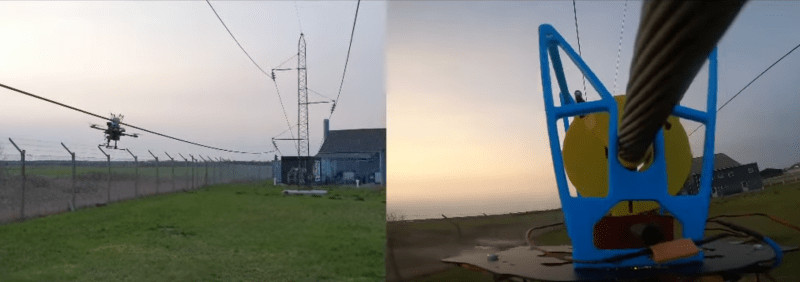Drones that charge right on the power lines they inspect is a promising concept, but comes with plenty of challenges. The Drone Infrastructure Inspection and Interaction (Diii) Group of the University of South Denmark is tackling these challenges head-on.
The gripper for these drones may seem fairly straightforward, but it needs to inductively charge, grip, and detach reliably while remaining simple and lightweight. To attach to a power line, the drone pushes against it, triggering a cord to pull the gripper closed. This gripper is held closed electromagnetically using energy harvested from the power line or the drone’s battery if the line is off. Ingeniously, this means that if there’s an electronics failure, the gripper will automatically release, avoiding situations where linemen would need to rescue a stuck drone.Accurately mapping power lines in 3D space for autonomous operation presents another hurdle. The team successfully tested mmWave radar for this purpose, which proves to be a lightweight and cost-efficient alternative to solutions like LiDAR.
We briefly covered this project earlier this year when details were limited. Energy harvesting from power lines isn’t new; we’ve seen similar concepts applied in government-sanctioned spy cameras and border patrol drones. Drones are not only used for inspecting power lines but also for more adventurous tasks like clearing debris off them with fire.
















I’m thinking a power line inspecting drone could move on the power lines instead of flying. I’m sure there already are devices that move on a cable. This obviously needs to move so that it can pass the electrical tower connection points, but those probably exist too. If not, doubt that it’s that hard of a problem. Just add an AI controller and get rich.
One problem for this is that if the power line is for trains or such, then the drone can’t be there when the train comes. Although, depending on what is inspected, the train can also have a device to inspect certain aspects of the line for preventive maintenance.
But i’m not an expert in this subject, that’s just a thought.
The inspection vehicle already needs to fly anyway in order to inspect the lines and pylons, so using that existing flight capability seems a lot simpler and cheaper than adding some overcomplicated mechanism to traverse the support insulators. And handily has the property that a failure mid-traverse cannot result in shorting the power lines to the support structure ground and taking out the infrastructure the drone is supposed to be protecting.
Not to mention the extremely wide variety of tower, insulator and even cable designs. There is at least one run near me that each set of insulators is supporting a triplet of conductors that are separated from each other by brackets all along the length of the cable.
A flying inspection drone would not care less about all these variables.
Add a couple of rollers and only turn on the back motors a little bit, so that it can crawl along
Bonus points if it looks like a circus clown pedaling a unicycle.
Good one! Here’s an internet cookie for you.
There are already overhead line inspections from trains, they basically shine a laser upwards and take imagery of the contact surface of the wire, which gives you the remaining thickness.
Oh. That’s why birds always sit there… I think this proves the point.
+1
…and when they’re sitting on phone/cable lines, they’re downloading new orders!
powerlines too. haven’t you seen the devices that can send data through power cables…?
Birds aren’t real!
;)
From the demo, it looks like the concept already works. Very impressive. A simple 1D lidar should be sufficient to dock with the cable. With a little automation, drones could easily travel long distances along power lines using this device.
A newer autonomous version of the drone already exists:
https://www.youtube.com/watch?v=C-uekD6VTIQ
How are the power companies cool with this?
Can we charge our other stuff for free if we used drones to connect?
I would like some free electricity.
I have no idea how power companies could possibly be happy for equipment monitoring their large capital investments for problems to be powered from those same large capital investments.
Here’s the link to the spy drone story https://hackaday.com/2010/06/28/cameras-perch-on-power-lines-steal-electricity/